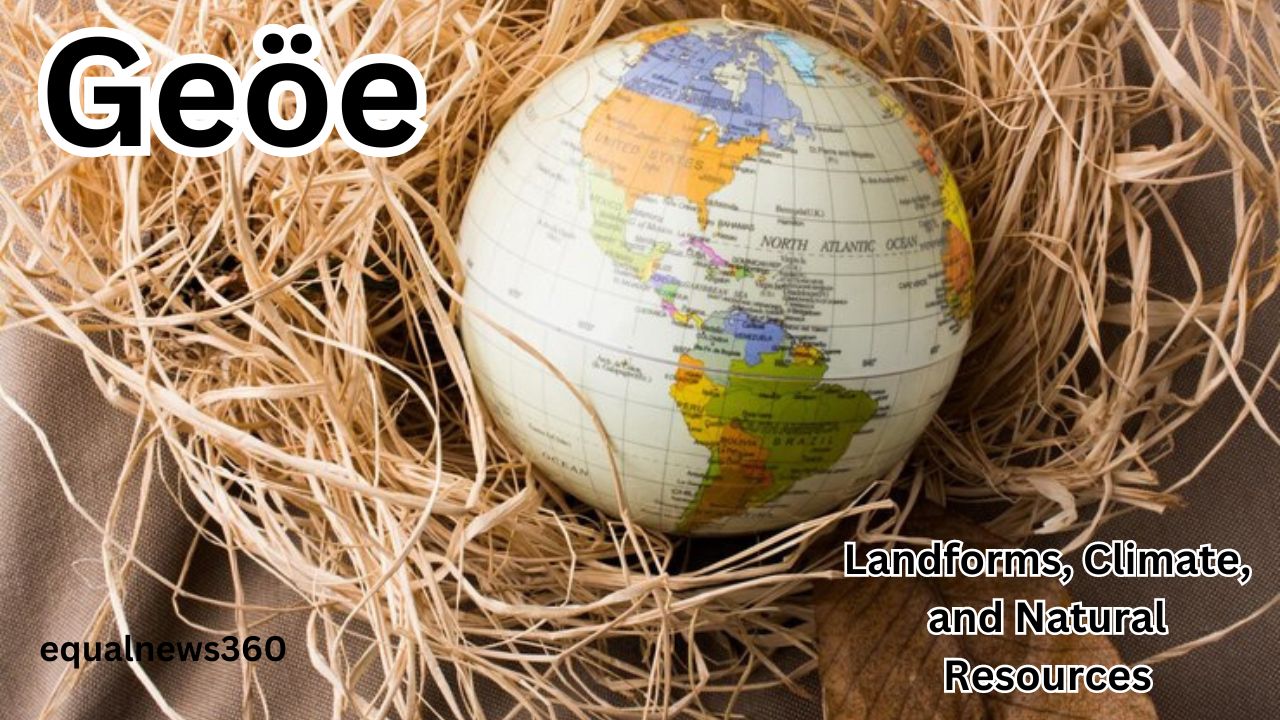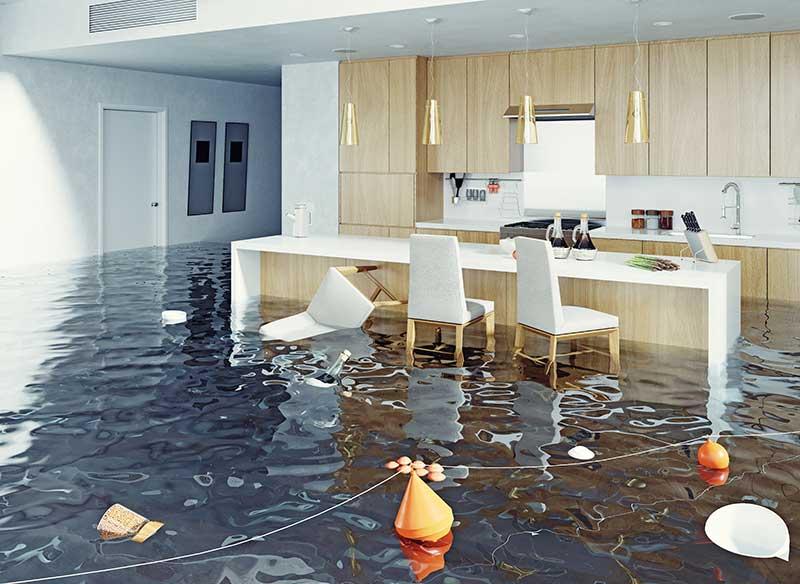NEWS
Geöe: The Interplay of Landforms, Climate, and Natural Resources
Published
6 months agoon
By
Saad
Welcome to the fascinating world of Geöe – where landforms, climate, and natural resources come together in a mesmerizing dance! Have you ever wondered how the shape of our Earth’s surface influences weather patterns? Or how climate conditions dictate the availability of vital resources like water, minerals, and energy? Prepare to be amazed as we delve into the interplay between these three essential elements.
Geoe is an exciting concept that explores the intricate relationship between landforms, climate, and natural resources. It helps us understand why certain regions are rich in specific minerals or experience extreme weather conditions. By unraveling this complex web of interactions, we gain valuable insights into our planet’s past and present while paving a path towards a sustainable future.
So fasten your seatbelts as we embark on a journey through mountains, valleys, deserts, oceans – exploring how they shape our environment and influence everything from agriculture to industry. Let’s dive right in!
The Impact of Landforms on Climate
Landforms, such as mountains, valleys, and plains, play a crucial role in shaping the climate of a region. These natural features interact with atmospheric conditions to create specific weather patterns and determine the overall climatic conditions.
Mountains act as barriers that influence wind patterns and precipitation distribution. As moist air rises over mountain ranges, it cools down and condenses into clouds, leading to increased rainfall on one side (the windward side) and a rain shadow effect on the other side (the leeward side). This phenomenon drastically affects the availability of water resources in different regions.
Valleys also impact climate by creating microclimates within larger regions. Due to their low-lying nature, valleys tend to trap cool air at night while allowing warm air from higher elevations during the day. This temperature inversion can result in temperature extremes between valley bottoms and nearby hillsides.
Plains generally have more moderate climates due to their relatively flat terrain. They allow for greater heat absorption during the day and radiate that heat back into the atmosphere at night. Additionally, plains often lack significant topographic features that would disrupt airflow or cause localized variations in weather patterns.
Understanding these landform-climate interactions is essential for various reasons: predicting agricultural productivity based on rainfall patterns; assessing water resource management strategies; planning infrastructure development considering extreme temperatures or precipitation events; evaluating potential impacts of climate change on vulnerable areas like coastal regions or arid zones.
By recognizing how landforms shape regional climates, scientists can develop models that help us comprehend present conditions better while also making predictions about future changes caused by both natural processes such as erosion or tectonic movements as well as human activities like deforestation or urbanization.
As we continue to study geoe – this interplay between landforms, climate, and natural resources – our knowledge grows ever deeper. With this understanding comes great responsibility: we must strive towards sustainable development practices that take into account the intricate balance between nature and human activity. Only
How Climate Affects Natural Resources
Climate plays a crucial role in shaping the availability and accessibility of natural resources. The intricate relationship between climate and natural resources has a significant impact on various aspects of human life, including food production, water supply, energy sources, and overall environmental stability.
One key way that climate affects natural resources is through precipitation patterns. Different regions experience varying levels of rainfall throughout the year, which directly influences the growth of crops and vegetation. For example, areas with high rainfall are often suitable for agriculture and support lush forests. On the other hand, arid regions with low precipitation struggle to sustain plant life or support agricultural activities.
Temperature also has a profound effect on natural resources. Extreme heat can lead to drought conditions and desertification, making it difficult for plants to survive. Conversely, colder climates may limit biodiversity by restricting the types of species that can thrive in frigid temperatures.
Additionally, climate change poses further challenges to natural resource availability. Rising global temperatures contribute to melting glaciers and polar ice caps, leading to sea-level rise and freshwater scarcity in coastal areas. These changes disrupt ecosystems both on land and underwater while impacting essential resources like clean drinking water.
The effects of climate on natural resources extend beyond land-based assets; they also influence marine habitats significantly. Warmer ocean temperatures can cause coral bleaching events that devastate coral reefs—the “rainforests” of our oceans—leading to habitat loss for countless marine species.
Understanding how climate impacts natural resources is crucial for sustainable resource management practices moving forward. By taking into account climatic factors when planning land use or implementing conservation strategies, we can mitigate potential negative consequences on our vital ecosystems while ensuring long-term resource sustainability.
Examples of Geoe in Action
1. The Himalayas and Monsoon Season: One prime example of the interplay between landforms, climate, and natural resources is found in the Indian subcontinent. The towering peaks of the Himalayas act as a barrier, blocking cold winds from Central Asia and creating a unique climatic phenomenon known as the monsoon season. This annual weather pattern brings heavy rainfall to India and surrounding regions, crucial for agriculture and water resources.
2. Coastal Erosion and Beach Tourism: Another fascinating example can be seen along coastal areas worldwide. Landforms such as cliffs or dunes play a vital role in protecting beaches from erosion caused by strong ocean currents or storms. When these protective features are altered due to human activities such as sand mining or construction, it can result in beach erosion that threatens tourism industries reliant on pristine shorelines.
3. Tundra Biome and Oil Extraction: In Arctic regions like Alaska or Siberia, frozen landforms called tundra dominate the landscape. These treeless expanses have vast reserves of oil beneath them but extracting this valuable resource presents significant challenges due to harsh climates and fragile ecosystems.
4. Rainforests’ Impact on Water Cycle: The lush rainforests found near the equator also exemplify how landforms influence climate patterns while providing essential natural resources. With their extensive vegetation cover acting like giant sponges, rainforests greatly contribute to regulating global temperatures through transpiration while maintaining high levels of precipitation necessary for sustaining both local communities and biodiversity.
5. Ocean Currents Shaping Fishing Industries: Ocean currents dictate temperature variations across different marine environments globally—impacting fish populations accordingly—and thus influencing fishing industries around coastlines ranging from Peru’s Humboldt Current to Japan’s Kuroshio Current.
These examples demonstrate just a few instances where geoe plays a critical role in shaping our world – impacting everything from agriculture to tourism, energy extraction to biodiversity. Understanding and harnessing this interplay between landforms, climate, and natural
The Role of Human Activity in Geoe
Human activity plays a crucial role in shaping geoe, the intricate interplay of landforms, climate, and natural resources. As we go about our daily lives, our actions can have both positive and negative impacts on the environment.
One way human activity influences geoe is through deforestation. When vast areas of forests are cleared for agriculture or urban development, it not only removes vital habitats for countless species but also disrupts the balance of carbon dioxide absorption. Trees act as natural carbon sinks, absorbing CO2 from the atmosphere and helping to regulate global temperatures. By cutting down trees at an alarming rate, we contribute to climate change.
Another significant aspect of human influence on geoe is pollution. From industrial emissions to improper waste disposal practices, our activities release harmful pollutants into the air, waterways, and soil. This contamination affects ecosystems and can lead to devastating consequences such as water scarcity or toxic soil that hinders agricultural productivity.
Furthermore, human activities like mining and extraction have a direct impact on natural resources. The indiscriminate removal of minerals or fossil fuels often results in habitat destruction and disturbs ecological balances. Additionally, overexploitation can deplete finite resources without allowing them time to replenish naturally.
However! It’s essential to note that humans also possess incredible potential for positive change when it comes to geoe! Through sustainable practices like reforestation efforts or transitioning towards renewable energy sources,! we can mitigate some of these detrimental effects.! By embracing eco-friendly technologies,! reducing greenhouse gas emissions,! implementing responsible resource management strategies,! we pave the way for a more sustainable future where geoe works in harmony with human needs!
Future Implications and Challenges of Geoe
As we look ahead to the future, it is clear that understanding and utilizing geoe will be crucial for sustainable development. The interplay between landforms, climate, and natural resources has significant implications for various aspects of our lives.
One key implication is in the realm of agriculture. Geoe can inform farmers about the best crops to grow in a particular region based on its landforms and climate. By harnessing this knowledge, farmers can maximize their productivity while minimizing environmental impact.
Another important implication lies in energy production. Geoe allows us to identify areas with high potential for renewable energy sources such as wind, solar, or hydroelectric power. By strategically locating these energy facilities, we can reduce our reliance on fossil fuels and move towards a more sustainable energy future.
However, there are also challenges associated with geoe. Climate change is altering traditional patterns of landforms and climates, making it difficult to predict future conditions accurately. This uncertainty poses challenges for planning infrastructure projects or managing natural resources effectively.
Additionally, human activities such as deforestation or pollution can disrupt the delicate balance between landforms, climate, and natural resources. We must recognize our role in shaping geoe dynamics and take proactive measures to mitigate negative impacts.
To address these challenges effectively requires interdisciplinary collaboration among scientists from different fields such as geography, climatology, ecology, and economics. By combining expertise from various disciplines along with advanced technologies like remote sensing or big data analysis techniques,, we can enhance our understanding of gene processes and develop innovative solutions for a more sustainable future.
Conclusion: Understanding and Utilizing Geoe for a Sustainable Future
In this article, we have explored the fascinating concept of Geoe – the interplay between landforms, climate, and natural resources. We have seen how landforms shape climate patterns and how climate influences the availability of essential natural resources.
By understanding these connections, we can make informed decisions about resource management, environmental conservation, and sustainable development. Geoe provides valuable insights into how different regions are affected by their unique geographical features and climatic conditions.
As we move towards a more sustainable future, harnessing the power of Geoe becomes increasingly important. By considering factors such as landforms and climate when planning infrastructure projects or implementing policies related to agriculture or energy production, we can minimize negative impacts on our environment while maximizing the efficient use of our resources.
For example, in coastal areas prone to hurricanes or flooding due to particular landforms like low-lying plains or barrier islands, it is crucial to develop resilient infrastructure that can withstand these natural hazards. Similarly, understanding the impact of changing climates on water availability allows us to implement responsible water management practices in arid regions.
Human activity plays a significant role in shaping Geoe dynamics. Land-use changes such as deforestation or urbanization can alter local climates and disrupt ecosystems. However, with careful planning and sustainable practices at both individual and collective levels, we can mitigate these negative effects.
The challenges posed by global issues like climate change necessitate an even greater emphasis on utilizing Geoe principles effectively. By recognizing that every region has its own unique set of geographical characteristics and associated challenges regarding climate variability or access to certain resources like minerals or renewable energy sources – we can tailor solutions specific to each area’s needs.
Achieving this vision requires collaboration among governments, scientists, businesses,s, and communities worldwide – working together towards common goals of sustainability, resilience, and prosperity for all.
Hi, I am Saad Qureshi and I am working since 2017 in this field with 5 years of experience in SEO and Guest posting. My range of services includes Article Posting on Authority Sites.

You may like
NEWS
Why Fiskning is the Ultimate Outdoor Adventure Activity
Published
2 months agoon
May 27, 2024By
Saad
Here in the exciting realm of Fiskning, excitement, and peace of mind coexist in the wide outdoors. The best outdoor activity if you want to mix adrenaline and leisure is Fiskning. Come explore with us the background, advantages, must-have gear, top travel spots, safety advice, and how Fiskning can change your outdoor adventures. Prepare to fully experience fishing as never before!
Fiskning History and Origins
Are you curious about the background and beginnings of Fiskning, the ultimate outdoor adventure sport? Fiskning has its origins in prehistoric Scandinavian societies where fishing was a way of life as much as a source of food.
Fishing became deeply embedded in the culture in these rough regions surrounded by magnificent fjords and glistening waterways as a means of sustaining communities and fostering a connection with nature. Fiskning became a popular past leisure for people of all ages worldwide as it developed from a simple survival technique.
Fiskning is not only a skill, patience, and enjoyment of nature activity; it is also a cultural legacy that should be preserved. As they throw their hooks into calm lakes or raging rivers in quest of that ideal catch, fans of the sport still appreciate the spirit of Fiskning today.
Advantages of Fishing for Mental and Physical Health
The best kind of outdoor adventure sport, fiskning has several advantages for mental and physical health. Fishing in and of itself calls for patience, concentration, and accuracy—qualities that might enhance cognitive performance and lower stress. Practicing Fiskning in the great outdoors helps people to unplug from the daily grind and cultivate mindfulness and calm.
Physically, Fiskning is a terrific approach to keeping active without seeming like you’re working out. A great full-body workout could be had by reeling in a large catch or stumbling across rugged terrain to find the ideal location. Outside time also exposes you to natural sunlight, which raises vitamin D levels and enhances happiness.
Fishing is about interacting with nature, pushing yourself both physically and emotionally, and enjoying the many health advantages that come with this fulfilling outdoor pursuit. It’s not only about catching fish.
Standard Fiskning Gear and Equipment
Equipping for a Fiskning excursion requires the proper gear to be effective and pleasurable.
A reliable fishing rod is a must; more experienced fishermen can choose from lighter spinning rods for novices to more specialist fly fishing rods. Match the specifications of the rod with a dependable reel.
Not to be overlooked is your line; select one that works for the kind of fish you want to catch and the conditions you will be in. Depending on your favorite fishing style, a range of lures or bait will also come in useful.
Must-have additional equipment includes hooks, sinkers, bobbers, and a tackle box to keep everything in order. Not to mention polarized sunglasses to shield your eyes and lessen glare off the water while you search for underwater movement.
Just as crucial to your kit list are comfortable clothes appropriate for the weather and sturdy shoes that can manage a variety of terrains.
Top Fishing Spots Worldwide
Set out on an exhilarating fishing journey and see some of the most stunning locations on Earth to land your biggest catch.
Beautiful fjords and glistening clean seas brimming with fish just ready to be hooked may be found in Scandinavia in nations like Sweden and Norway. Unforgettable fishing experiences are perfectly framed by the stunning scenery.
For those who long for a tropical getaway, travel to Australia or Costa Rica to go fishing in the warm sun amongst fascinating marine life and verdant surroundings. These places’ brilliant hues will make your fishing trip even more exciting.
If you enjoy your fishing and culture mixed, the coastal areas of Japan are perfect for fishermen who want to experience traditional Japanese culture while attempting to catch native species like mackerel and tuna.
Anyplace you decide to throw your line has its special appeal and promises to be an unforgettable fishing experience that will make you want more.
Guide to Safe Fishing
Safety has to be the first concern whenever you go on a Fiskning trip. Look up the water and weather predictions before leaving. To avoid slipping on damp surfaces, dress for the weather and wear appropriate, well-grip shoes.
Remember to pack life jackets and first aid kits among other necessary safety equipment. In case of emergency, it’s also critical to let someone know where you fish and when you anticipate returning.
Even if fisking can be a thrilling sport, you should always be mindful of your surroundings. When working with sharp equipment and hooks, especially around kids or novice fishermen, use caution.
Assure a sustainable experience for the environment and yourself by adhering to local fishing laws and regulations. You may thoroughly enjoy this outdoor experience with peace of mind if you give safety precautions priority when planning your Fiskning excursion.
Finally, how fiskning may be a transformative experience
Fishing is a life-changing event that goes beyond simple leisure. The excitement of landing your first fish and the tranquility of being outdoors provides a special chance to establish a connection with the environment and oneself.
Fiskning offers plenty to offer everyone, whatever of your interests—adventure, leisure, or just some time away from daily life. Try your hand at Fiskning the next time you’re seeking a new outdoor experience; you never know, it might well transform your life.
NEWS
DIY Vs. Professional Water Damage Restoration: Pros and Cons
Published
5 months agoon
March 5, 2024By
Saad
Water damage restoration isn’t as straightforward as it might seem. It involves more than wiping up a few puddles; it requires proper inspection, thorough drying, and sometimes even reconstruction.
Taking on such a project without professional help might save you money upfront but can also lead to long-term issues. Analyzing the benefits and drawbacks of doing your water damage repair is crucial.
Cost
Professionals offer expertise and advanced equipment, allowing them to tackle water damage more thoroughly than homeowners could. This may come at a higher upfront cost, but it can save you money in the long run by reducing future problems like mold growth and structural damage.
Homeowners on a tight budget may find DIY restoration appealing due to its potential cost savings. However, it’s essential to consider all the costs associated with attempting DIY repairs, including time, energy, and risks.
Taking on a DIY restoration project can be a great learning opportunity for homeowners looking to improve their skills. Plus, it’s a chance to take personal pride in their work. But be aware that it’s also a very time-consuming process. Many people are busy, and tackling water damage restoration in the middle of a hectic lifestyle can be challenging. For example, homeowners may work on the project during weekends or after work.
Safety
Many homeowners try DIY projects to save money. In some situations, this makes sense. However, skipping professional water damage restoration Denver services can be more trouble than it’s worth in water damage restoration.
Water damage repair is a complicated process that includes water extraction, thorough drying and dehumidification, meticulous cleaning, and even mold removal. Inexperienced homeowners may make mistakes that lead to additional issues, such as structural damage and mold growth.
It’s also important to consider personal safety when deciding on a DIY project. If you’re dealing with contaminated water (often called “black water”), it may be hazardous to your health. Removing water-logged carpets and other materials can be physically challenging and stressful. DIYers often don’t wear proper safety equipment, and the job can be dangerous even with appropriate gear. I’ve seen countless well-intentioned DIYers get hurt trying to rip out wet carpets or pry up damaged drywall. They can end up with costly injuries and a home that’s less safe for their family.
Time
Water damage can have profound implications if not addressed fast, including structural damage to your property, mold growth, and pricey repairs. When faced with water damage, homeowners may do DIY restoration or hire professional services. Here are some pros and cons to help you decide which option is best for your situation.
Pros: DIY can be cost-effective, especially for minor issues like leaky pipes or spills. It’s also a great way to learn skills and get involved in your home’s maintenance. It can be a rewarding experience, and you will feel a sense of accomplishment once the project is complete.
Cons: It can be very time-consuming to restore your home yourself. Tearing down drywall, removing wet carpet, and using fans and dehumidifiers to extract moisture are labor-intensive tasks. It can take days or even weeks to dry a space completely. This can be inconvenient if you have a busy schedule.
Experience
Homeowners often turn to DIY water damage restoration to save money, but it isn’t easy without experience. Inexperience can lead to missed areas of damage, improper drying techniques, and potential structural problems. These mistakes can cost homeowners much more than their initial out-of-pocket costs; they could also drive up the price of future insurance premiums or long-term repair bills.
Whether to attempt DIY restoration or call in professionals depends on various factors, including the extent of the damage, health and safety concerns, insurance coverage, time constraints, and budget considerations. A DIY approach may be worth the savings for minor water damage within your capabilities. However, hiring a professional service is often safer and more cost-effective for larger-scale or contaminated water damage.
NEWS
A Winter Weather Advisory Issued for northern Minnesota and Northwest Wisconsin.
Published
5 months agoon
March 4, 2024By
Saad
Brrr! Brace yourselves, folks in Northern Minnesota and Northwest Wisconsin – winter is here with a vengeance! A winter weather advisory has been issued, heralding the arrival of snow, ice, and bone-chilling temperatures. It’s time to grab your mittens, stock up on hot cocoa, and hunker down for some serious cold weather ahead. Let’s dive into what this advisory means for you and how to stay safe during the frosty days to come.
What caused the advisory to be issued?
As the temperatures drop and the winds pick up, residents of northern Minnesota and northwest Wisconsin are bracing themselves for a winter weather advisory. The primary cause behind this advisory is an approaching low-pressure system from the west that is expected to bring heavy snowfall and gusty winds to the region. This potent combination can create hazardous conditions on roads, leading to reduced visibility and slippery surfaces.
The National Weather Service has issued this advisory to alert residents of the potential dangers posed by this incoming winter storm. With significant snow accumulation predicted, it’s crucial for people in these areas to take precautions and prepare accordingly. Schools may be closed, travel could be disrupted, and power outages might occur due to downed trees or power lines under the weight of heavy snow.
By staying informed through local news updates and official weather alerts, individuals can stay ahead of any developments as they unfold during this winter weather event. It’s essential for everyone in the affected areas to heed safety recommendations from authorities so that they can navigate through these challenging conditions with caution and awareness.
What areas are affected by the advisory?
As the winter weather advisory sweeps across northern Minnesota and northwest Wisconsin, several areas are expected to be impacted by this upcoming storm. Residents in cities like Duluth, Superior, Grand Marais, and Ashland should prepare for potentially hazardous conditions.
The advisory covers a wide area from the shores of Lake Superior to the inland regions near the Canadian border. Even smaller towns and rural communities in these regions may experience heavy snowfall, strong winds, and freezing temperatures.
Roads and highways in these areas could become treacherous as snow accumulates quickly, reducing visibility and creating slippery driving conditions. Travelers are urged to stay updated on road closures and travel advisories issued by local authorities.
Residents living in these affected areas should stock up on essential supplies like food, water, batteries, blankets, and any necessary medications ahead of the storm. It’s crucial to have a plan in place for power outages or emergencies during severe winter weather events.
Expected weather conditions and potential hazards
The upcoming winter weather in northern Minnesota and northwest Wisconsin is forecasted to bring heavy snowfall, strong winds, and low visibility. These conditions can create hazardous driving conditions, leading to accidents and road closures. Additionally, the weight of the snow accumulation on roofs can pose a risk of collapse.
Residents in the affected areas should prepare for possible power outages due to downed power lines or trees weighed down by snow. It’s essential to have emergency supplies like food, water, blankets, and flashlights readily available in case you lose electricity.
Travel should be limited during this time to reduce the risk of getting stranded on the roads. If you must go out, make sure your vehicle is equipped with winter tires, chains if needed, and an emergency kit.
Stay informed about updated weather forecasts and advisories from local authorities to ensure your safety during this winter storm warning period. Your well-being is a top priority when facing these potential hazards brought on by severe winter weather conditions.
Tips for preparing for winter weather
As winter weather approaches, it’s essential to be prepared for whatever nature may throw your way. Start by checking your heating system to ensure it’s in good working condition. Stock up on supplies like extra blankets, non-perishable food, and water in case of power outages. Don’t forget to have a flashlight with fresh batteries handy.
Make sure your vehicle is equipped with essentials like an ice scraper, shovel, sand or kitty litter for traction, and a fully charged phone in case you need help while driving in snowy conditions. Consider investing in snow tires or chains for added safety on the road.
Keep an emergency kit at home with first aid supplies, medications, and important documents stored in a waterproof container. Stay informed about weather updates and advisories by tuning into local news stations or signing up for alerts on your phone. By taking these proactive steps, you can stay safe and prepared during the winter season.
What to do during a winter storm
When a winter storm hits, it’s important to stay indoors if possible. Keep your home warm by sealing any drafts and using extra blankets or layers of clothing. Make sure you have enough food, water, and medications to last a few days in case of power outages.
If you must go outside, dress warmly in layers and cover exposed skin to prevent frostbite. Use caution when walking on icy sidewalks or roads – wear appropriate footwear with good traction. Drive only if absolutely necessary, and make sure your vehicle is equipped with emergency supplies like a shovel, kitty litter for traction, and a fully charged phone.
Stay informed about weather updates through local news sources or weather apps on your phone. If you lose power, avoid using candles as they pose a fire hazard; opt for flashlights instead. Check on neighbors who may need assistance during the storm – community support is essential during challenging conditions like these.
Conclusion: Stay safe and informed during winter weather advisories
Stay safe and informed during winter weather advisories. Remember to stay updated on the latest weather forecasts, travel warnings, and road conditions. Prepare your home and vehicle for inclement weather by stocking up on supplies like food, water, blankets, and a flashlight. Follow safety guidelines if you must travel during a winter storm, such as driving slowly and keeping a safe distance from other vehicles.
By staying vigilant and taking precautions, you can protect yourself and your loved ones during severe winter weather conditions in Northern Minnesota and Northwest Wisconsin. Stay warm, stay safe!

01174411569 is a unique number that has gained significant attention in recent times. It is not just a number; it represents a revolutionary concept that is reshaping the way we think about communication and connectivity.
History and Origin
The history of 01174411569 can be traced back to [insert year], when [company name] first introduced this concept to the public. Since then, it has evolved into a powerful tool that is used by millions of people around the world.
Benefits of 01174411569
There are several benefits to using 01174411569. One of the key benefits is its ability to [insert benefit]. Additionally, 01174411569 is [insert another benefit].
How Does 01174411569 Work?
01174411569 works by [explain how it works]. This process ensures that users can [explain user benefits].
Use Cases of 01174411569
01174411569 has a wide range of use cases. For example, it can be used for [insert use case]. Additionally, it is also used in [insert another use case].
Comparison with Other Solutions
When compared to other solutions, 01174411569 stands out because of [explain unique selling points].
Future of 01174411569
The future of 01174411569 looks promising, with [explain future prospects].
How to Get 01174411569
To get 01174411569, [explain how to obtain it]. This process is simple and straightforward, ensuring that anyone can [obtain it].
Conclusion
In conclusion, 01174411569 is a revolutionary concept that is changing the way we communicate. With its [list key benefits], it is clear that 01174411569 is here to stay.
FAQs
- Question: What is the cost of 01174411569?
- Answer: The cost of 01174411569 varies depending on [explain cost factors].
- Question: Can I use 01174411569 internationally?
- Answer: Yes, you can use 01174411569 internationally. However, [mention any restrictions].
- Question: Is 01174411569 secure?
- Answer: Yes, 01174411569 is secure. It uses [explain security features].
- Question: How long does it take to set up 01174411569?
- Answer: Setting up 01174411569 is quick and easy, usually taking [mention time frame].
- Question: Can I use my existing number with 01174411569?
- Answer: Yes, you can use your existing number with 01174411569. However, [mention any compatibility issues].
Trending
-

 ENTERTAINMENT5 months ago
ENTERTAINMENT5 months agoHBO Max TV Sign In Guide
-

 FASHION7 months ago
FASHION7 months agoJourney of Sandra Orlow From Aspiring Model to Internet Sensation
-

 TRAVEL6 months ago
TRAVEL6 months agoUnveiling the Beauty: A Closer Look at myfavouriteplaces.org Blog
-

 NEWS7 months ago
NEWS7 months agoBench Craft Company Lawsuit: A Comprehensive Analysis
-

 BUSINESS7 months ago
BUSINESS7 months agoChina SEO Xiaoyan: Pioneering the Path in Chinese Digital Marketing
-

 FASHION5 months ago
FASHION5 months agoThe Rise of Jeansato: A Revolutionary Denim Trend
-

 ENTERTAINMENT5 months ago
ENTERTAINMENT5 months agoGeekzilla Podcast: Navigating the Geek Cosmos
-

 TECH7 months ago
TECH7 months agoExploring Fibahub – Your Ultimate Solution for Seamless Communication
